In a salary cap league, every dollar matters. Teams must be able to get as much value out of their players as possible which means making smart financial decisions as one bad contract can affect a team’s future. Even with that in mind, front offices continue to give out bad contracts and they become handcuffed to those deals.
Some teams, like the Buffalo Sabres and Detroit Red Wings, have multiple bad contracts that limit their ability to be competitive while others, like the Nashville Predators and St. Louis Blues, aren’t seriously hindered by any of their deals. With that being said, which contract is the worst for each of the 31 franchises?
All deals discussed will be bad from a team perspective and all salary information can be found on The Hockey Writers team salary cap pages.
Anaheim Ducks
C Ryan Kesler – $6.875 million Average Annual Value (AAV) through 2021-22
When Kesler plays, he is a productive player with recent back-to-back 50-point seasons. He has also been remarkably healthy throughout his career considering the physical style of game he plays. He missed a total of nine regular-season games over the past four seasons prior to this one. However, offseason hip surgery held him out of the lineup until Dec. 27.

The extension he signed in 2015, carries a No-Move Clause (NMC) for the next three seasons and a Modified No-Trade Clause (M-NTC) in the final season. Considering his age (33) and cap hit, he is all but unmovable at this point in his career.
Arizona Coyotes
C Derek Stepan – $6.5 million AAV through 2020-21
Stepan’s contract isn’t bad by most standards and because the Coyotes have immense cap space, no contract is truly terrible for them. Stepan’s deal carries the biggest cap hit on the roster and runs as long as anyone else’s. He is paid like a first line center when, ideally, he is a second line center, never scoring more than 57 points in a season. In his first season with the Coyotes, he has been productive with 41 points in 65 games but is still overpaid. He also has a full No-Trade Clause (NTC) next season and a M-NTC for the last two seasons, giving Stepan most of the power.
Boston Bruins
C/RW David Backes – $6 million AAV through 2020-21
If this list was put together last season, the Bruins would have been a lot easier to figure out as both Backes and David Krejci had bad years. This season, both players have rebounded nicely and their contracts run the same length and have the same trade protection, but Backes is older.
Although 33, Backes remains a possession-driver and improves his linemates’ play at 5-on-5. However, his contract doesn’t expire for another three seasons, it has a full NMC attached to it, and he will be 37 when it ends. The deal itself isn’t terrible, but it will impact Boston’s ability to re-sign their free agents and sign others in the summer.
Buffalo Sabres
RW Kyle Okposo – $6 million AAV through 2022-23
When Kyle Okposo was a New York Islander he had four 50-plus point seasons but he has topped out at 45 points with the Sabres. He will turn 30 on Apr. 16 and is already regressing in key areas, including shots-per-60 which have dropped for the third straight season. His shooting percentage of 8.09 is his lowest since the 2012-13 season.
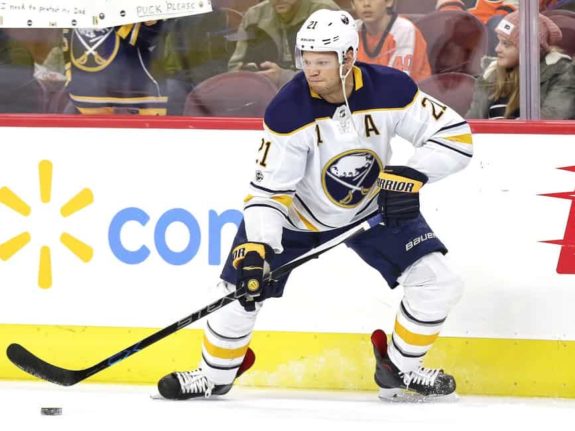
Okposo has five years left on his deal with a M-NTC. He is not unmovable, though, as he has a proven track record of production. It also helps that the actual salary is front-loaded and he will only make $4 million the last two years of the deal.
Calgary Flames
RW Troy Brouwer – $4.5 million AAV through 2019-20
Since the Flames signed Brouwer to a four-year, $18 million contract following the 2015-16 season, he has been a great disappointment. Calgary signed him to provide offense on the bottom six but he has regressed since joining the Flames. Individually, his shot attempts and chances created per 60 minutes have decreased each season since 2012-13 and at 5-on-5 he is propped up by linemates, especially when on a line with Mikael Backlund. Brouwer has two years left on his deal with a M-NTC after this season and is able to be traded but would require the Flames retaining salary.
Carolina Hurricanes
G Scott Darling – $4.15 million AAV through 2020-21
Goaltender Scott Darling has been awful for the Hurricanes. Carolina acquired then re-signed him last offseason to a four-year, $16.6 million contract with a M-NTC. The contract showed faith that Darling could be the reliable starting netminder the Hurricanes have missed. Despite playing behind a good, young defense, Darling has an .890 save percentage in all situations that drops to .814 on the penalty kill.
At 29, Darling could still bounce back next season but right now his contract is bad for the Hurricanes. There are more problems with the organization than Darling but in a league where it’s best to build from the net out, he has to be better.
Chicago Blackhawks
D Brent Seabrook – $6.875 million AAV through 2023-24
The Chicago Blackhawks have several questionable contracts but none are worse than Brent Seabrook’s. In fact, Seabrook’s eight-year, $55 million deal may be the worst in the league. It lasts for another six years with a NMC that runs through 2021-22 and then a M-NTC for the final two years. He signed his extension after helping the Blackhawks win their third Stanley Cup in six years.
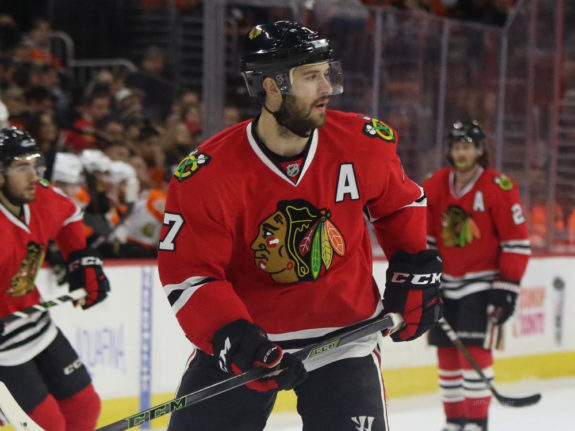
At 32, Seabrook should still be worth his contract but he isn’t, with just 19 points in 66 games this season. Given the trade protection he has, Seabrook is unmovable unless he waives his rights. If there is anything positive about the contract, it’s that it is front-loaded and pays him $9 million the first three years but just $4.5 million in the final year.
Colorado Avalanche
D Erik Johnson – $6 million AAV through 2022-23
Johnson’s contract isn’t that bad and he is playing well with Nikita Zadorov. He will be 34 when his $6 million cap hit expires, much younger than others on this list. He also only has a M-NTC that requires him to submit a 19 team approval list, giving the Avalanche opportunity to move him if necessary. Johnson’s contract is the Avalanche’s worst because he is one of just three players under contract for at least three more years.
Columbus Blue Jackets
C Brandon Dubinsky – $5.85 million AAV through 2020-21
Brandon Dubinsky’s $5.85 million cap hit pays him like a top-six forward while his 15 points in 49 games are closer to the production of a third or fourth liner. He has had a steady dropoff in production at 5-on-5 with a points-per-60 rate that has regressed for three straight seasons. Dubinsky’s physical play won’t age well considering he misses stretches of each season due to injury or suspension. The good news for the Blue Jackets is that his NMC becomes a M-NTC next season, opening up the possibility of getting out from under his cap hit.
Dallas Stars
C Martin Hanzal – $4.75 million AAV through 2019-20
The Dallas Stars signed Hanzal last offseason after he had 13 points in 20 games for the Minnesota Wild following the Trade Deadline. The deal the Stars signed him to – three years, $14.25 million with a M-NTC the next two years – reflected the high price the Wild paid to acquire him. This season, he has 10 points in 38 games and has recently found himself on the fourth line. That is an epic overpayment for an unproductive fourth line center. The good news is that he is able to be traded starting next season, his contract only lasts another two years, and the actual salary paid is at its highest this season.
Detroit Red Wings
C Frans Nielsen – $5.25 million AAV through 2021-22
Frans Nielsen’s lack of production has more to do with the talent surrounding him than his own. When he signed his deal with Detroit in 2016, he was coming off a 52-point campaign with the New York Islanders. It was probably slight overpayment but not as bad as other contracts. What makes his contract so bad is that the Red Wings are in a rebuild and need to strip their NHL roster before they are good again.
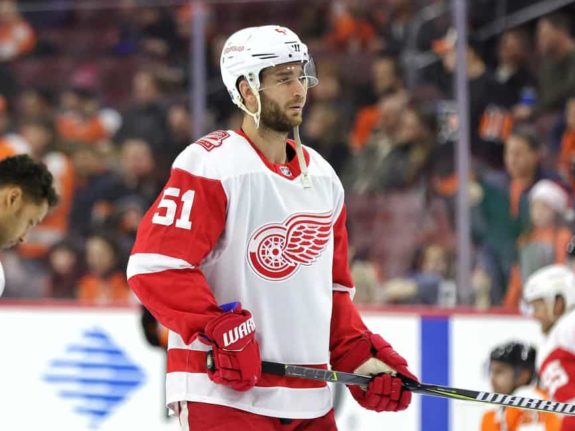
Nielsen has 28 points in 66 games this season and isn’t worth his cap hit but there is still a good chance he gets traded this offseason. The NMC he had in the first two years becomes a M-NTC for the remaining years and the actual salary starts decreasing after next season. Nielsen has value, but for now, he is a hindrance to the Red Wings’ rebuild.
Edmonton Oilers
LW Milan Lucic – $6 million AAV through 2022-23
This one was easy. The Oilers have four contracts that go beyond 2020-21: Connor McDavid, Leon Draisaitl, Oscar Klefbom, and Milan Lucic. Lucic will turn 30 this summer and is having one of his worst seasons. The Oilers signed him to bring size and leadership and to protect their star players. Even if he has brought those elements, he was also supposed to provide some offense. That hasn’t happened with just 32 points in 66 games this season.
Lucic has a NMC for the next three years and a M-NTC in the final two. Given his lack of production this early in the deal, trading Lucic is unthinkable. That is a problem for a team that needs to add speed on the wings with few internal options available.
Florida Panthers
G Roberto Luongo – $5,333,333 AAV through 2021-22
The Panthers were a difficult team because they don’t have any awful deals. I chose Roberto Luongo because of the combination of his age and the term left on the deal. Luongo will turn 39 in early April and, while he is still a good goaltender with a .927 save percentage, he has suffered injuries in recent seasons. Before the last lockout, he signed for 12 years, $64 million allowing a manageable cap hit but he will be 43 when the deal expires.
The redeeming factor in the deal is that the salary drops from $6.714 million this season to $3.382 next and to $1 million in the final year. At his age, Luongo is unlikely to be traded so Florida is stuck with the contract for the duration.
Los Angeles Kings
D Dion Phaneuf – $5.25 million AAV through 2020-21
The Kings were one of the most difficult teams from which to choose a bad contract. Both Dustin Brown and Jonathan Quick’s deals have the potential to be nightmares in the final years but both players are having good seasons. The recently acquired Dion Phaneuf is the team’s worst contract as a result. Phaneuf’s total cap hit is $7 million but the Ottawa Senators are retaining $1.75 million per year for the duration of the deal. Phaneuf is overpaid as a $7 million defenseman but is closer to his true value at $5.25 million. Since joining the Kings, Phaneuf has six points in 10 games and has been a good partner for Alec Martinez. His contract isn’t a problem right now but he will be 36 at the end of the deal, at which point he will be overpaid again.
Minnesota Wild
LW Zach Parise – $7,538,642 AAV through 2024-25
Both Zach Parise and Ryan Suter are terrible contracts for the Minnesota Wild. They joined the team after signing identical 13-year, $98 million deals with a NMC during the 2012 offseason.
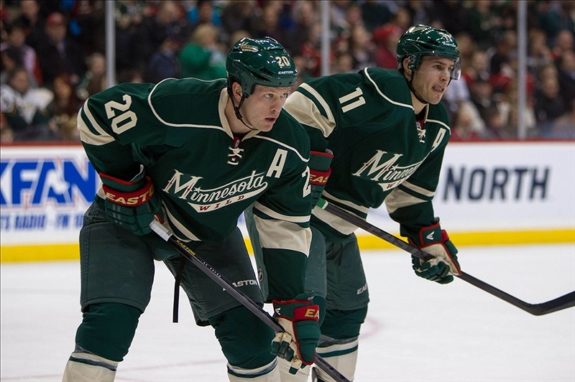
What makes Parise’s worse is the drop off in his play. Parise was a great player early in his career and was productive in his first four seasons with the Wild, ranging between .76 and .84 points-per-game. However, he hasn’t played a full season since the lockout-shortened 2012-13 season because of injuries. This season, he missed time after having back surgery and didn’t play until Jan. 2. Since returning, he has 13 points in 28 games. Although the contract is already bad, it will only continue to get worse.
Montreal Canadiens
G Carey Price – $10.5 million AAV through 2025-26
When healthy, Carey Price is the best goalie in the world, but injuries in recent seasons have capped his value. Price’s eight-year, $84 million extension with a NMC doesn’t start until next season. There are several factors why the deal is bad for Montreal. The first is Price will be 31 when the deal goes into effect and the ageing curve for goalies is steeper than for skaters. The other factor is that no team has won a Stanley Cup with a goaltender making at least $10 million. Canadiens’ GM Marc Bergevin had no choice but to extend Price. If he had traded him or let him test free agency, fans would have called for Bergevin’s job. He got the deal done but will be handcuffed for the next eight years.
Nashville Predators
C Ryan Johansen – $8 million AAV through 2024-25
Okay, so this deal isn’t bad for the Nashville Predators, but they don’t have any bad ones. GM David Poile has made a habit of not including trade protection in his deals. He paid Ryan Johansen like a first line center with an eight-year $64 million deal. The contract is slightly too high compared to the production levels of other first line centers but it is a deal Poile had to make. Johansen is only 25 years old and will be 33 when the deal expires so a regression due to his age is unlikely. The deal also guaranteed that five of Nashville’s top six forwards are signed through the 2019-20 season which means that they have locked down their core for several runs at a Stanley Cup.
New Jersey Devils
D Andy Greene – $5 million AAV through 2019-20
I went back-and-forth with who should represent the Devils. I thought about Travis Zajac or Cory Schneider but ultimately landed on Andy Greene. Greene’s contract only has a cap hit of $5 million and runs for just two more seasons but he is 35 and has a NTC. Greene’s biggest issue is that he is unproductive with 11 points in 66 games this season which would be worse if he wasn’t being propped up at 5-on-5 by Sami Vatanen. He has not surpassed the 20-point mark since the 2014-15 season.
New York Islanders
LW Andrew Ladd – $5.5 million AAV through 2022-23
It is hard to believe that Andrew Ladd averaged at least a half-point per game in six consecutive seasons. His production led to a seven-year, $38.5 million deal from the New York Islanders as a replacement for Kyle Okposo. He is in his second season with the club and has 22 points in 58 games this season, including one point in his past 13 games.
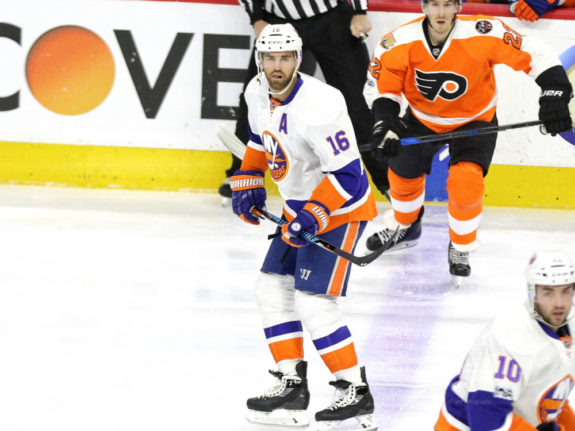
At 32, Ladd isn’t even that old but his production is unlikely to rebound as he ages. The contract he signed gave him the same cap hit as John Tavares and remains tied for second highest among forwards on the team. It doesn’t get any easier moving forward as the contract has a NTC for the next two years that becomes a M-NTC in the final three.
New York Rangers
G Henrik Lundqvist – $8.5 million AAV through 2020-21
King Hank has shown this season that he is still an elite goaltender. His play isn’t the reason his contract is the worst on the Rangers. It’s because Lundqvist just turned 36 and has three years left on the deal with a NMC. With his various injuries in recent seasons and how goaltenders age, he won’t be worth the cap hit in the last couple of years. With the Rangers in the midst of a rebuild, Lundqvist could waive his NMC to finish his career contending for a Stanley Cup but that is unlikely as he loves being a Ranger.
Ottawa Senators
W Bobby Ryan – $7.25 million AAV through 2021-22
Bobby Ryan was the subject of trade rumors heading into this year’s Trade Deadline as the Senators attempted to get rid of his contract. In 2014, the Senators signed him to a seven-year, $50.75 million deal that has four years remaining. In the first year of the deal, he had 56 points but he hasn’t reached 30 points in a season since and injuries have limited his production that past two seasons. Ryan’s contract has a M-NTC so the Senators can’t trade him to just any team. The worst part is that it is back-loaded and its highest salary is in the final four years of the deal.
Philadelphia Flyers
D Andrew MacDonald – $5 million AAV through 2019-20
Defenseman Andrew MacDonald is in year four of a six-year deal with a $5 million cap hit and a salary that increases each season until it expires. Because MacDonald has never scored 30 points in a season and hasn’t reached 20 points in his four as a Flyer, this contract was always overpayment. He ranks third among Flyers defensemen in time on ice and fourth in points with 14 in 51 games while having the largest cap hit at the position. This season at 5-on-5, he is also below 50 percent in shot control and goal control. At 31, MacDonald isn’t old but isn’t worth his contract. He doesn’t have any trade protection so the Flyers could move him to free up cap space if necessary.
Pittsburgh Penguins
D Kris Letang – $7.25 million AAV through 2021-22
For much of his career, Kris Letang has been one of the most exciting defensemen in the league. He brings an elite offensive game and his skating ability is as strong as anyone. The issue is that Letang’s extensive injury history makes his contract a liability for the Penguins. He has suffered at least three diagnosed concussions and a stroke and that doesn’t include a serious upper-body injury that kept him out of last year’s playoffs. Letang will be 31 on Apr. 24 and with his history of serious injuries, any hits from behind or contact to the head could mean a career-threatening injury.
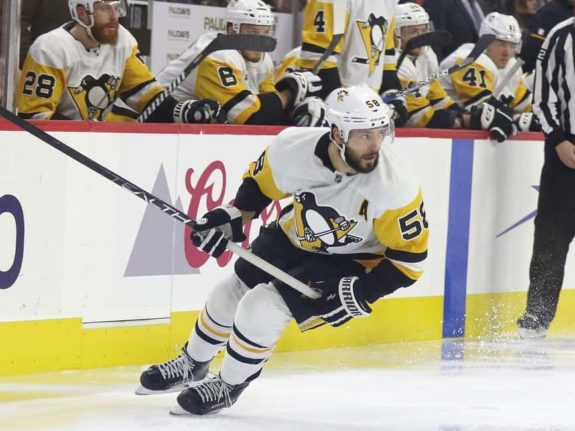
San Jose Sharks
D Brent Burns – $8 million AAV through 2024-25
Brent Burns is in the first year of the eight-year extension he signed in Nov. 2016. Although he has struggled to score goals this season, he has still been productive with 52 points in 66 games. The problem with Burns’ contract is that he is already 33 and will be 40 when his deal expires. Another issue is that he has one of the strictest M-NTCs with only three teams required on his list. If he picks teams that don’t have the cap space for his contract, a trade would be impossible. If there is a bright side to the deal, it’s that after the fourth year, the actual salary decreases every season until it expires.
St. Louis Blues
LW Alexander Steen – $5.75 million AAV through 2020-21
With Paul Stastny’s contract off the books and Jay Bouwmeester’s expiring after next season, the Blues don’t have any real bad contracts. I chose Steen because he is 34 and in the first year of a four-year, $23 million extension. The deal also has a NTC that runs through Feb. 1, 2021, which allows him to be traded at the deadline of the final year. On the ice, Steen is still productive with 39 points in 60 games this season. However, with a goal total that is on pace to decrease for the fourth straight season, he won’t be worth his cap hit all four years.
Tampa Bay Lightning
RW Ryan Callahan – $5.8 million AAV through 2019-20
The Tampa Bay Lightning signed Ryan Callahan to his current deal following a trade from the New York Rangers. The six-year, $34.8 million deal was only worth it in year one when Callahan had 54 points in 77 games. Since then, he has been overpaid, with totals of 47 points in the three seasons since, including 15 in 58 games this season.
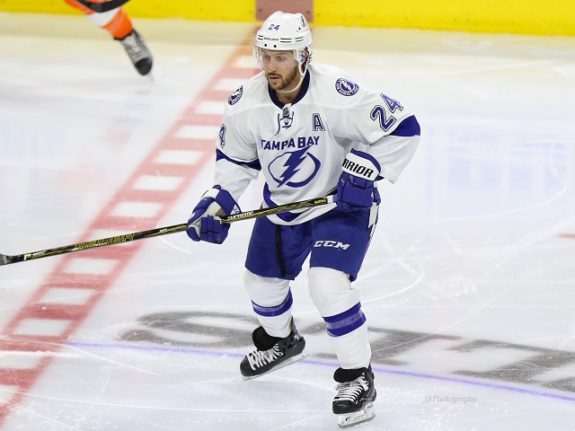
It’s not just his production that isn’t worth it, it’s also his injury history. He has never played a full season in his career and only appeared in 18 games last season after undergoing hip surgery. He has already missed time this season with an upper-body injury that kept him out of the lineup from Dec. 14 to Jan. 4.
Toronto Maple Leafs
RW Nathan Horton – $5.3 million AAV through 2019-20
Nathan Horton hasn’t played a game since 2014 and has been on Long-Term Injured Reserve (LTIR) since. Players on LTIR typically don’t affect the team much but in the case of the Toronto Maple Leafs, it could. Although these players offer salary cap relief during the season, teams are only allowed to go 10 percent above the cap ceiling including player contracts on LTIR during the offseason. So, with a team like the Maple Leafs that will be up against the salary cap when their young players leave their ELCs, Horton’s contract could become problematic. It would not be surprising to see Horton’s contract moved this offseason to allow the Maple Leafs more room to sign players.
Vancouver Canucks
LW Loui Eriksson – $6 million AAV through 2021-22
The Vancouver Canucks signed Loui Eriksson during the 2016 offseason to play on a line with fellow Swedes, Daniel and Henrik Sedin. The problem with the signing is that the Canucks are now in the middle of a rebuild, less than two years later. In his two seasons with the Canucks, Eriksson has 21 goals and 47 points. His 23 points this season are ninth on the team while he has the third-highest cap hit. As long as Eriksson’s contract is on the books, a rebuild in Vancouver will be tough. With four more seasons and a NTC the next two years, trading Eriksson will be difficult.
Vegas Golden Knights
RW David Clarkson – $5.25 million AAV through 2019-20
The Vegas Golden Knights acquired David Clarkson’s contract at the Expansion Draft from the Columbus Blue Jackets. Clarkson hasn’t played a game since March 2016 and has been on IR since. This doesn’t really affect the Golden Knights because of how much cap space they have but Clarkson is still Vegas’ worst contract because they built their roster to avoid bad contracts. Even Clarkson’s deal expires in two seasons and the salary goes below the cap hit after this season. Vegas may have the best worst contract in the league.
Washington Capitals
RW T.J. Oshie – $5.75 million AAV through 2024-25
T.J. Oshie is in the first year of an eight-year, $46 million extension he signed last June. After a 33-goal campaign last season, the extension seemed like a no-brainer. With a $5.75 million cap hit, Oshie appeared to be a value signing for the Capitals. The issue now is that Oshie is 31 and only has 12 goals and 36 points in 61 games this season.
While it’s unlikely that he will be this bad again, he also may never reach last season’s totals again when he shot a league-leading 23.1 percent. When the deal expires, Oshie will be 38 and he was already past his prime when he signed the deal.
Winnipeg Jets
C Bryan Little – $5,291,666 AAV through 2023-24
The Winnipeg Jets signed second line center Bryan Little to a six-year, $31.75 million extension in Sept. 2017. The resulting $5,291,666 AAV isn’t bad for a second-line center but his scoring rate is down to .55 points-per-game this season. The contract has a NMC the first two years that becomes a M-NTC in the final four so Little is movable. The impact of the contract will be felt most when the Jets re-sign Jacob Trouba, Josh Morrissey, Tyler Myers, Patrik Laine, and Kyle Connor in the next two years.